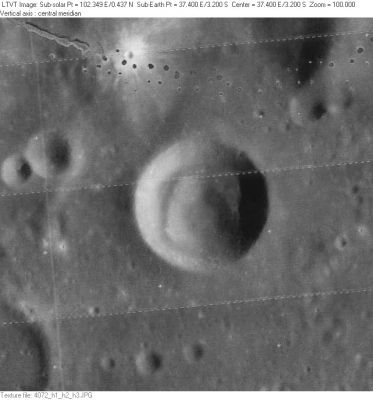Leakey
Contents
Leakey
(formerly [/Censorinus Censorinus] F)
| Lat: 3.2°S, Long: 37.4°E, Diam: 12 km, Depth: 1.8 km, Rükl: 47 |
Table of Contents
[#Leakey Leakey]
[#Leakey-Images Images]
[#Leakey-Maps Maps]
[#Leakey-Description Description]
[#Leakey-Description: Wikipedia Description: Wikipedia]
[#Leakey-Additional Information Additional Information]
[#Leakey-Nomenclature Nomenclature]
[#Leakey-LPOD Articles LPOD Articles]
[#Leakey-Bibliography Bibliography]
 LOIV 072 H3 Leakey is in the center, viewed here from the south. See also the following Lunar Orbiter view, showing Leakey as seen from the north, and their combination as a red-blue stereo image.
LOIV 072 H3 Leakey is in the center, viewed here from the south. See also the following Lunar Orbiter view, showing Leakey as seen from the north, and their combination as a red-blue stereo image.Images
LPOD Photo Gallery Lunar Orbiter Images Apollo Images
- AS10-33-4907, made during the mission of Apollo 10, shows Leakey near the right margin of the photograph. Note the bright ray-craterlet near Leakey.
- Two additional Apollo photos can be found with the old name misspelled
- AS10-35-5210 shows the region northwest of Gutenberg, with concentric (?) crater Leakey below (and a tittle bit to the left) of the image's centre (north is leftward).
- High-sun orbital close-ups of Leakey are seen here, in Apollo 16's ITEK-panoramic photographs: AS16-P-5264, AS16-P-5269, and AS16-P-5271 (scroll to the right at all three frames, note the bright ray-craterlet nearby Leakey!).
- Leakey's concentric shape is also noticeable at far right of ITEK-frames AS16-P-4492 and AS16-P-4497. Note the nearby bright ray-craterlet!
- Research Apollo photographs: Danny Caes
- To explore the LRO's close up of the bright ray-craterlet's floor and inner slopes: LON 37.25, LAT -2.74 (4, 2, or 1 M/PIX), at the ACT-REACT Quick Map. - DannyCaes DannyCaes Jun 13, 2011
- LRO's close up of the bright ray-craterlet's ejectablanket is seen in the LPOD Swept Away.
Maps
([/LAC%20zone LAC zone] 79A2) LAC map Geologic map AIC map LTO map
Description
Description: Wikipedia
Additional Information
- Depth data from [/Kurt%20Fisher%20crater%20depths Kurt Fisher database]
- Westfall, 2000: 1.8 km
- Viscardy, 1985: 1.35 km
- Is this a [/concentric%20crater concentric crater]?
- It certainly looks that way, and is drawn as one on AIC 79A. The maker of the Geologic map (using [/Lunar%20Orbiter Lunar Orbiter] imagery -- see his diagram below the map) suspected an inner ring of "subdued crater" material-- but the later LTO 79A2 (based on stereo mapping of AS16-M-2935 - AS16-M-2938) fails to catch anything but a basic bowl shape in its contours. Nonetheless, when the Lunar Orbiter views are combined into a stereo image of their own it appears that Leakey's basic shape is not bowl-shaped, but rather resembles a common type of ice cream cone. The main rim has straight tapered walls leading down to a flat shelf into which is punched a second set of straight tapered walls leading to a final flat floor at the bottom. The appearance of the inner ring noted on the Geologic map comes from material that appears to be piled primarily on the northwest part of the intermediate shelf. - JimMosher JimMosher Nov 20, 2007
- The Wikipedia authors have a quite different interpretation of Leakey's shape, regarding it as a bowl shape with a ring of low albedo material on the floor. - JimMosher JimMosher Nov 21, 2007
Nomenclature
- Named for Louis Seymour Bazett Leakey (August 7, 1903 – October 1, 1972), a Kenyan archaeologist and naturalist whose work was important in establishing human evolutionary development in Africa. In natural philosophy he asserted Darwin's theory of evolution unswervingly and set about to prove Darwin's hypothesis that man arose in Africa. One of Louis's greatest legacies stems from his role in fostering field research of primates in their natural habitats, which he understood as key to unraveling the mysteries of human evolution. He personally chose three female researchers, Jane Goodall, Dian Fossey, and Birute Galdikas, who were later dubbed 'Leakey's Angels' and each went on to become important scholars in the field of primatology.
- This replacement name for a formerly [/lettered%20crater lettered crater] was provisionally introduced on LTO-79A2, for which it served as the chart title. It was among 120 names from the [/LTO LTO]'s approved by the IAU in 1976 ([/IAU%20Transactions%20XVIB IAU Transactions XVIB]). - JimMosher JimMosher
LPOD Articles
Swept Away (LRO's close up of the bright ray-craterlet's ejecta nearby Leakey)
Bibliography
This page has been edited 1 times. The last modification was made by - tychocrater tychocrater on Jun 13, 2009 3:24 pm - afx3u2